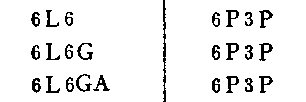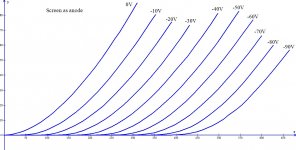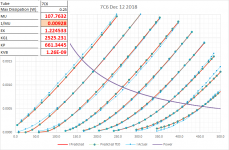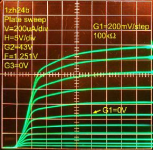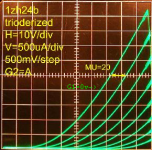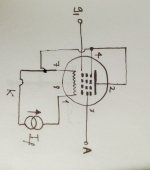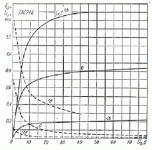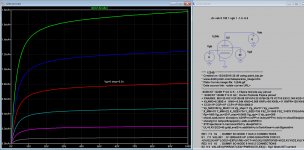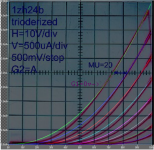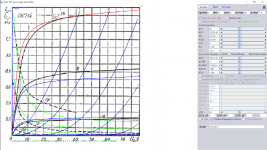Hi all,
God news for all ultra low noise HiFi freaks, and for those interested in RF or pulsed circuits!
I just released my latest triode spice model, a 8808 Nuvistor, one of the best triode regarding noise.
The achieved fit-quality is presented here:
http://adrianimmler.simplesite.com/440956786
kind regards, Adrian
God news for all ultra low noise HiFi freaks, and for those interested in RF or pulsed circuits!
I just released my latest triode spice model, a 8808 Nuvistor, one of the best triode regarding noise.
The achieved fit-quality is presented here:
http://adrianimmler.simplesite.com/440956786
kind regards, Adrian
Hi all,
I just released my latest triode spice model, a 8808 Nuvistor, one of the best triode regarding noise.
kind regards, Adrian
Great efforts, Adrian, thank you for sharing your work! I need a model for PCF201 amongst other tubes I have, but I don't know how to make it. Which software do you use for modelling? 😕
Last edited:
Hi rankot
Thanks for your feedback. I develop my models manually, that means plotting the curves with LTspice while overlaying a semitransparent diagram, from measured data or data sheet curves. I also have a excel sheet and the solver add-on for least mean square fit of the params, but it is not stable (why ever).
The PCF201 is a very difficult tube to model, because it's a remote cut off. The only approach I know that satisfies such behavior is from Derk Reefman (look at dos4ever.com).
kind regards, Adrian
Thanks for your feedback. I develop my models manually, that means plotting the curves with LTspice while overlaying a semitransparent diagram, from measured data or data sheet curves. I also have a excel sheet and the solver add-on for least mean square fit of the params, but it is not stable (why ever).
The PCF201 is a very difficult tube to model, because it's a remote cut off. The only approach I know that satisfies such behavior is from Derk Reefman (look at dos4ever.com).
kind regards, Adrian
Hi rankot
I also have a excel sheet and the solver add-on for least mean square fit of the params, but it is not stable (why ever).
Adrian:
With "Solver" try using "log squashed error" -- a trick I got from Nutonian:
=LN(1+ABS(Actual_current - Predicted_Current))
for instance Log squashed error =LN(1+ABS(V16-T16))
It's also important to paramaterize the params to reasonable values.
Unhappily, Nutonian was acquired and they no longer seem to support Eurequa's small license holders.
Nice work Adrian, do you have a model for the 6s33s with both triodes working ?
Thanks
No, I don't. But I guess it should be easy to find a suitable spice model. A google search with ".subckt 6s33s" delivers several results.
regards, Adrian
Just connect two of them together in the simulator.do you have a model for the 6s33s with both triodes working ?
1j24b spice model request for smallest russian submini tube
1Ж24Б aka 1j24b aka 1zh24b aka 1sh24b smallest russian submini tube
Maybe better luck this time ?
Here is both pentode and triode curve measurement for spice model.
Thank you in advance ...
1Ж24Б aka 1j24b aka 1zh24b aka 1sh24b smallest russian submini tube
Maybe better luck this time ?
Here is both pentode and triode curve measurement for spice model.
Thank you in advance ...
Attachments
Do you mean triode-connected? i.e., the screen is connected to the anode?On the characteristics of tube 813 screen as anode axis X-Volt, Y-mA anode
Unfortunately, the model created by the Ayumi method using the traced triode curves does not match up to either to the traced pentode curves or to the datasheet. Perhaps you can trace it again but with higher voltage like those shown in the datasheets?1Ж24Б aka 1j24b aka 1zh24b aka 1sh24b smallest russian submini tube
Maybe better luck this time ?
ThanksNo, I don't. But I guess it should be easy to find a suitable spice model. A google search with ".subckt 6s33s" delivers several results.
regards, Adrian
Since there is no data provided for such connection in the datasheets, so how do you know the characteristic of your model is correct or not?
Hello.
I downloaded the characteristics myself in such a connection, checking if there was a mistake and everything is OK. And this is not my first description.
Piotr
I downloaded the characteristics myself in such a connection, checking if there was a mistake and everything is OK. And this is not my first description.
Piotr
Hi, I want to model but I ran into difficulty: the tube is cut off about 5V, and about 10V for triode. In other word the curve origin is quite a distance from 0, 0 as compared with other sharp cut off tube. I wonder whether it is due to tracer or actually is like that?1Ж24Б aka 1j24b aka 1zh24b aka 1sh24b smallest russian submini tube
Maybe better luck this time ?
Here is both pentode and triode curve measurement for spice model.
Thank you in advance ...
Last edited:
Ok, found original Pentode curve: ''GSTube.com''. Tubes, sockets etc. Parameters and characteristics 1Zh24b
Here is the model, fill in the capacitances:
Here is the model, fill in the capacitances:
Code:
* [URL="http://www.dmitrynizh.com/tubeparams_image.htm"]Model Paint Tools: Trace Tube Parameters over Plate Curves, Interactively[/URL]
* Plate Curves image file: 1z24b.gif
* Data source link: <plate curves URL>
*----------------------------------------------------------------------------------
.SUBCKT 1Z24B P G2 G K ; LTSpice tetrode.asy pinout
* .SUBCKT 1Z24B P G K G2 ; Koren Pentode Pspice pinout
+ PARAMS: MU=20 KG1=23159.88 KP=574.32 KVB=26.78 VCT=0 EX=2.149 KG2=18871.78 KNEE=2.891 KVC=1.688
+ KLAMG=6.389E-4 KNK=-0.044 KNG=0.006 KNPL=50 KNSL=11 KNPR=120 KNSR=29
+ CCG=1P CGP=1P CCP=1P RGI=2000.0
* Vp_MAX=80 Ip_MAX=1.8 Vg_step=1 Vg_start=1 Vg_count=9
* X_MIN=70 Y_MIN=22 X_SIZE=734 Y_SIZE=736 FSZ_X=1550 FSZ_Y=878 XYGrid=false
* Rp=1400 Vg_ac=20 P_max=0.0495 Vg_qui=-3 Vp_qui=300
* showLoadLine=n showIp=y isDHP=n isPP=n isAsymPP=n isUL=n showDissipLimit=n
* showIg1=n isInputSnapped=y addLocalNFB=n
* XYProjections=n harmonicPlot=y dissipPlot=n
* UL=0.43 EG2=45 gridLevel2=n addKink=y isTanhKnee=n advSigmoid=n
*----------------------------------------------------------------------------------
RE1 7 0 1G ; DUMMY SO NODE 7 HAS 2 CONNECTIONS
E1 7 0 VALUE= ; E1 BREAKS UP LONG EQUATION FOR G1.
+{V(G2,K)/KP*LOG(1+EXP((1/MU+(VCT+V(G,K))/SQRT(KVB+V(G2,K)*V(G2,K)))*KP))}
RE2 6 0 1G ; DUMMY SO NODE 6 HAS 2 CONNECTIONS
E2 6 0 VALUE={(PWR(V(7),EX)+PWRS(V(7),EX))} ; Kg1 times KIT current
RE21 21 0 1
E21 21 0 VALUE={V(6)/KG1*ATAN(V(P,K)/KNEE)} ; Ip with knee but no slope and no kink
RE22 22 0 1 ; E22: kink curr deviation for plate
E22 22 0 VALUE={V(21)*LIMIT(KNK-V(G,K)*KNG,0,0.3)*(-ATAN((V(P,K)-KNPL)/KNSL)+ATAN((V(P,K)-KNPR)/KNSR))}
G1 P K VALUE={V(21)*(1+KLAMG*V(P,K)) + V(22)}
* Alexander Gurskii screen current, see audioXpress 2/2011, with slope and kink added
RE43 43 K 1G ; Dummy
E43 43 G2 VALUE={0} ; Dummy
G2 43 K VALUE={V(6)/KG2*(KVC-ATAN(V(P,K)/KNEE))/(1+KLAMG*V(P,K))-V(22)}
RCP P K 1G ; FOR CONVERGENCE
C1 K G {CCG} ; CATHODE-GRID 1
C2 G P {CGP} ; GRID 1-PLATE
C3 K P {CCP} ; CATHODE-PLATE
R1 G 5 {RGI} ; FOR GRID CURRENT
D3 5 K DX ; FOR GRID CURRENT }
.MODEL DX D(IS=1N RS=1 CJO=10PF TT=1N)
.ENDS
*$
* The following triode model is derived from pentode model, see above.
* In the triode model, all spice parameters come directly from the pentode model, except for Kg1,
* which for triode-strapped pentodes is derived from pentode's Kg1, Kg2 and Kvc as
*
* 4Kg1Kg2 / ((2Kvc-Pi)(2Kg1+PiKg2))
**** 1Z24B ******************************************
* Created on 12/24/2018 22:49 using paint_kit.jar 4.7
* [URL="http://www.dmitrynizh.com/tubeparams_image.htm"]Model Paint Tools: Trace Tube Parameters over Plate Curves, Interactively[/URL]
* Plate Curves image file: 1z24b.gif
* Data source link: <plate curves URL>
*----------------------------------------------------------------------------------
.SUBCKT TRIODE_1Z24B 1 2 3 ; Plate Grid Cathode
+ PARAMS: CCG=1P CGP=1P CCP=1P RGI=2000
+ MU=20 KG1=70624.82 KP=574.32 KVB=26.78 VCT=0 EX=2.149
* Vp_MAX=80 Ip_MAX=1.8 Vg_step=1 Vg_start=1 Vg_count=9
* Rp=1400 Vg_ac=20 P_max=0.0495 Vg_qui=-3 Vp_qui=300
* X_MIN=70 Y_MIN=22 X_SIZE=734 Y_SIZE=736 FSZ_X=1550 FSZ_Y=878 XYGrid=false
* showLoadLine=n showIp=y isDHT=n isPP=n isAsymPP=n showDissipLimit=n
* showIg1=n gridLevel2=n isInputSnapped=y
* XYProjections=n harmonicPlot=y dissipPlot=n
*----------------------------------------------------------------------------------
E1 7 0 VALUE={V(1,3)/KP*LOG(1+EXP(KP*(1/MU+(VCT+V(2,3))/SQRT(KVB+V(1,3)*V(1,3)))))}
RE1 7 0 1G ; TO AVOID FLOATING NODES
G1 1 3 VALUE={(PWR(V(7),EX)+PWRS(V(7),EX))/KG1}
RCP 1 3 1G ; TO AVOID FLOATING NODES
C1 2 3 {CCG} ; CATHODE-GRID
C2 2 1 {CGP} ; GRID=PLATE
C3 1 3 {CCP} ; CATHODE-PLATE
D3 5 3 DX ; POSITIVE GRID CURRENT
R1 2 5 {RGI} ; POSITIVE GRID CURRENT
.MODEL DX D(IS=1N RS=1 CJO=10PF TT=1N)
.ENDS
*$Attachments
Last edited:
- Home
- Amplifiers
- Tubes / Valves
- Vacuum Tube SPICE Models
